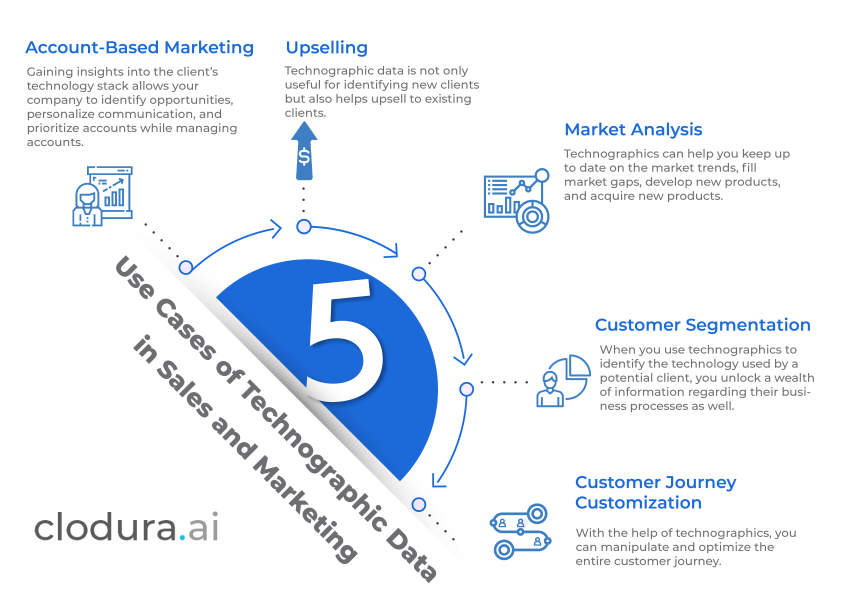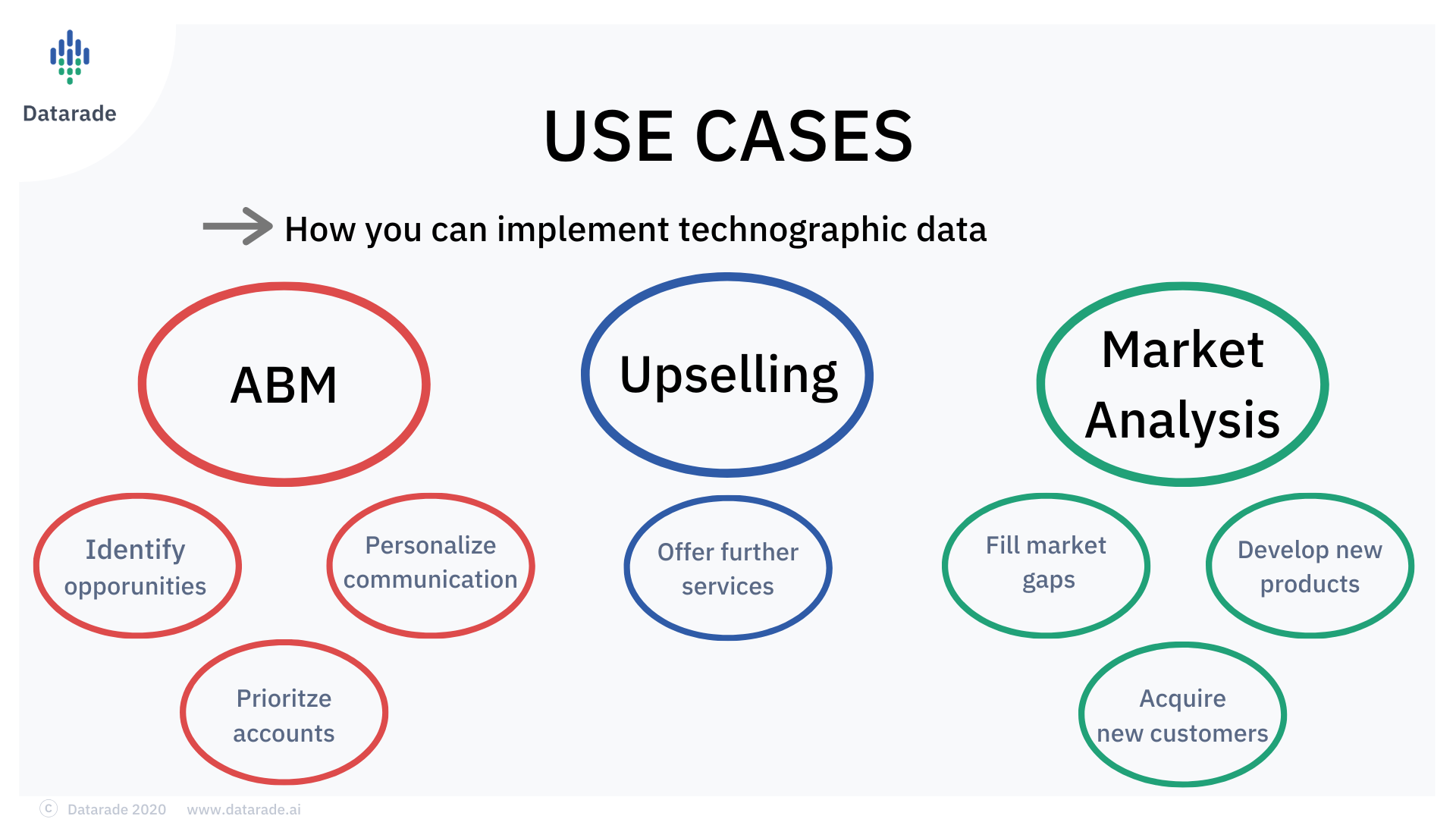The Importance of Technographics for Sales Process

Image Source: clodura.ai
When two competitors identify the same target audience and access similar demographic and firmographic data, who wins?
The company that has access to their target audience’s technographic data, of course.
Technographics, umm, what does that mean?
What are Technographics?
Technographics are data-driven insights that help businesses identify which accounts are most likely to convert based on the knowledge of their current technology stack.
In essence, technographic data gives you an insight into the technology and tools used by your target accounts. This allows you to effectively market to the accounts that are most likely to convert based on their current technology stack.
Why should you care about Technographics?
The thing about the 21st century is that there is no resisting it. With the astonishing rate at which technology is evolving, you either adapt or perish.
Brands have been utilizing data such as demographic and firmographics since the later 2000s. Yet, there has always been a gap in such a class of data. For example, they can tell you about a company’s size and diversity but fail to explain how tech-friendly these companies are. They also fail to communicate the buyer’s propensity to spend on new technologies with sales and marketing teams.
That’s where technographics come in. Technographic is the last piece of cake that completes the biblical “Buyer Intent Data.”
Today, with a better understanding of a prospective customer’s technology stack, technographics have become an essential part of the sales process. In a world of all but equal solutions, technographics adds a layer of superior customer experience to help you get an edge over your competitors.

Image Source: datarade.ai
Customer Data: The Key to Improving Sales Process
In a study by McKinsey, it is stated that 53% of “high performing” sales organizations attribute their growth to data and analytics. And as the cost of acquisition increases, your sales team needs to focus on gathering data that gives a holistic view of your target audience.
According to a Business Application Research Center (BARC) survey of 559 businesses, a data-driven sales process stated that data-driven sales increased their profits by 8% and reduced their cost of operations by 10%.
Therefore, technographics add a dimension of technological intelligence on top of a brand’s demographic and firmographic data. The 3rd dimension added to technographics is the last missing piece of writing the perfect pitch, nailing a sales presentation, and finding the right target audience.
So let’s look at how technographics help companies gain that extra edge for sales.
1. Precise and Targeted Prospecting
The first stage of the sales process, Discovery, is where a sales team identifies their target buyer personas and goes after them.
Technographics can drastically improve your buyer persona dataset. There are two specific ways in which you can find the ideal prospects to pitch:
- Technographics enables any sales rep to find out beforehand about any competitors being used by the prospect. This enables them to utilize sales collaterals that showcase the strengths of their product against the competitor.
- The sales rep can also identify the ideal prospects by examining their pipeline and seeing who has software that readily integrates with their platform.
2. Predictable Purchase Drivers
Understanding the technographics of your target audiences enables sales and marketing professionals to predict a company’s technical feasibility and budget. For instance, if a company has a well-established technology stack meant to accommodate multiple use-cases, it means they are likely to have a large budget for new technologies. Also, companies that have recently implemented new technologies in your niche might be doing product trials.
Access to technographics allows sales professionals to gain granular data on a company’s current technology budget and how they use it. Understanding this information will enable your sales team also to take cost into account while pitching the product. Therefore removing pricing-based friction out of the way.
3. Crafting Personalized Messaging
It’s no surprise that today’s customers demand a more personalized journey. We are living in the age of personalization. For a complete 360-view of a prospective customer, technographics is the last piece of the pie. Technographic data could add another dimension to the level of personalization to craft relevant messages to your targeted accounts.
For example, when equipped with the knowledge that a target account is heavily invested in Marketo, a potential CRM salesperson can customize an outreach strategy to highlight how their CRM complements Marketo’s marketing automation expertise. They can also highlight, in another example, the deep integration of their CRM with Marketo.
This depth of knowledge can transform how your ideal customer profiles, go-to-market strategy, and sales and marketing outreach strategies, ultimately reducing conversion windows and improving revenue.
4. Improve Target Audience Identification
According to a recent study, 64% of salespeople spend their time on work that doesn’t generate any revenue. Additionally, one-fifth of that time is spent on account research and prospecting.
Technographics can reduce this drastically by helping salespeople identify customers by targeting specific technology used by your current pool of customers. And at the same time, it will help you identify people you should avoid in the first place.
By incorporating technographic data into your ideal customer profiling activities, you can create a more accurate representation of your Total Addressable Market.
5. Better ROI for Account-Based Marketing
During the initial stages of account-based marketing (ABM), there is much guesswork into figuring out what the client wants. However, by being able to understand the customer’s account’s requirements from the get-go, a salesperson can:
- Engage with the right target prospect based on their technology buying habits.
- Create relevant content for their prospect, whether it’s an introductory call or a product presentation.
- Create custom personalized offers to undercut and overdeliver than their current solution or competitors.
- Understand the level of complexity of their technology stack. And, does your offering currently fit or replace something in their tech stack?
- A technographics sales team can identify the right opportunities with every ABM campaign based on their prospect’s propensity to buy a particular product. This allows them to tailor resources and cut down the excess expenditure to acquire the new account.
Conclusion
Technographics is one of the most valuable datasets for any sales and marketing team around the globe. It adds a new dimension to the sales process and brings in information people didn’t think was relevant while pitching their products to potential buyers.
But!
Today in the information age, technographics have become one of the most successful drivers in improving sales revenue, shortening sales cycles, and creating some of the world’s best-ever sales processes.
Sell more, understand your customers’ journey for free!
Sales and Marketing teams spend millions of dollars to bring visitors to your website. But do you track your customer’s journey? Do you know who buys and why?
Around 8% of your website traffic will sign up on your lead forms. What happens to the other 92% of your traffic? Can you identify your visiting accounts? Can you engage and retarget your qualified visitors even if they are not identified?



